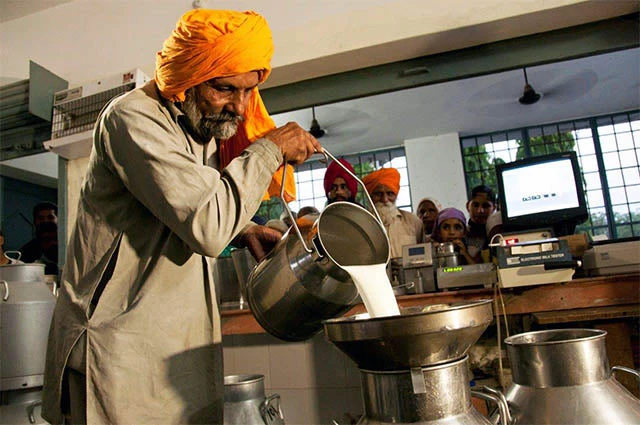
India is the world’s largest producer as well as consumer of milk and milk products. India nevertheless faces a shortage of milk and milk products due to increasing demand from the fast growing middle class in the country.
The National Dairy Plan Phase I (NDP-I), a Central Sector Scheme of the Government of India, which is supported by National Dairy Support Project (NDSP), aim to increase milk productivity and market access for milk producers, which are both necessary to meet the growing demand for milk. NDP-I is being implemented with a total investment of about US$350 Million, out of which the Bank has extended a Credit of US$219 Million through the NDSP.
The National Dairy Development Board (NDDB) is the main implementing agency for the NDP-I. At the decentralized level, NDP-I is being implemented by about 150 end‐implementing agencies (EIAs) scattered over the country.
The Project involves some innovative procurement practices and improvements in upstream milk supply chain, which are described below:
Supply chain strengthening for village-based milk procurement:
There are currently about 15 million milk producers in India, who are members of about 150,000 village dairy cooperatives. As milk is a highly perishable item, any weakness in the upstream supply chain may result in milk spoilage before reaching the processing plants.
Challenges include:
- detecting possible adulteration
- determining milk purchase price for each of the milk producers at the purchasing point in real time
- ensuring milk producers maintain hygiene while bringing milk to collection centers.
To address the above challenges, the NDSP financed EIAs’ purchase and installation of bulk milk chillers (BMC) at village milk collection points, which generate savings in transportation, operations, handling and processing costs. For streamlining milk collection and testing for quality of the milk supplied, EIAs also purchased standardized Automated Milk Collection Units (AMCU) and Data Processor-based Milk Collection Units (DPMCU) at collection centers along with associated IT systems. Adulteration testing kits were also supplied. These EIAs also procured Milk Cans and provided them to producers to ensure hygiene while bringing milk to collection centers. As on date about US$50 Million have been committed for strengthening of the upstream supply chain. Village-level infrastructure for milk collection and bulking has also helped in faster release of payment to milk producers.
The NDSP also encouraged formation of new village-level cooperatives to bring new producers to supply the milk. Since the mid-point of the project’s implementation period, 23,487 villages have been covered and 660,935 additional milk producers have organized. Upon completion of the NDSP, this component is likely to result in incremental annual financial gains of US$38 Million.
Framework Agreements for Decentralized Procurement of equipment:
About 150 EIAs across the 18 participating states of India require some standard items repeatedly (for example, Bulk Milk Cooling Unit). Because of this and the varying capacity among the EIAs, NDDB proposed the use of Framework Agreements (FA) for such items. In NDSP, FA were centrally set-up by NDDB but are being operated by EIAs, who issue purchase orders and release payments.
As the EIAs had never used FA in the past, a series of training workshops were organized for them. Time taken in placing purchase orders under FA is 18‐25 days (in comparison to National Competitive Bidding or NCB, which is around 120 days and shopping which is around 30‐45 days). It was also noted that on average 4.9 Proposals have been received for FA, which is higher than average for NCB in most Bank-financed projects. Use of FA has not only resulted in accelerating procurement process but also in monetary saving up to 15% in many cases.
Procurement oversight and quality assurance:
In regards to decentralized procurement of equipment oversight under the NDSP, the NDDB hired the services of a reputable inspection agency for quality checking of items procured by EIAs under FA arrangements. To minimize the scope for any deficiency in quality of items supplied, a Quality Assurance Plan (QAP) was developed for each item, and inspections started right from the manufacturing stage of equipment. Apart from detection and rectification of defects in items by the supplier, these proactive measures resulted in cancellation of FA of some suppliers, who were unable to adhere to required quality standards. Third party QA for civil works was also arranged. Monitoring integrity of the procurement process at this level was handled by a NDDB-hired professional. These findings were used by NDDB to design capacity building program for EIAs.
A web-based Procurement management information system (MIS) was developed to help NDDB monitor utilization of FA set-up by it as well as overall progress on decentralized procurement. The MIS also helped EIAs in sharing data among each other.
Tweet these:
#India faces dairy shortages due to demand from a growing middle class.
Innovative procurement practices help dairy sector in #India.
Strengthening the supply chain for village-based milk procurement.
Innovative procurement practices help stem milk shortages in #India.


Join the Conversation